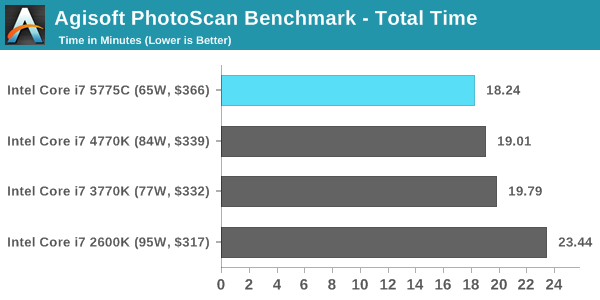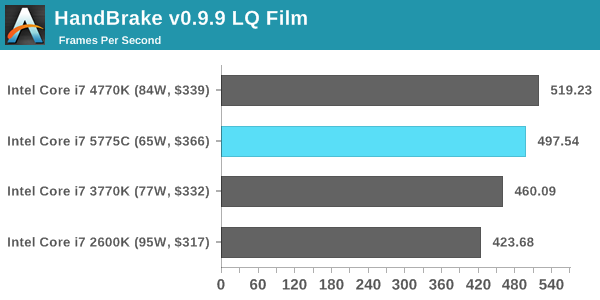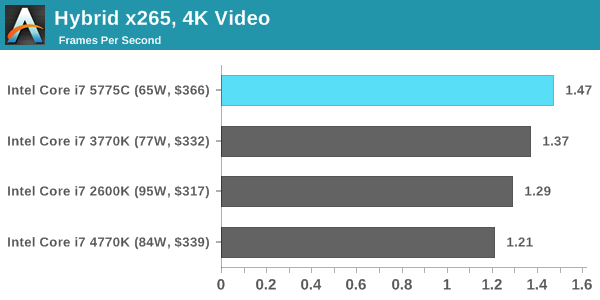The Intel Broadwell Review Part 2: Overclocking, IPC and Generational Analysis
by Ian Cutress on August 3, 2015 8:00 AM ESTProfessional Performance: Windows
Agisoft Photoscan – 2D to 3D Image Manipulation: link
Agisoft Photoscan creates 3D models from 2D images, a process which is very computationally expensive. The algorithm is split into four distinct phases, and different phases of the model reconstruction require either fast memory, fast IPC, more cores, or even OpenCL compute devices to hand. Agisoft supplied us with a special version of the software to script the process, where we take 50 images of a stately home and convert it into a medium quality model. This benchmark typically takes around 15-20 minutes on a high end PC on the CPU alone, with GPUs reducing the time.

Cinebench R15
Cinebench is a benchmark based around Cinema 4D, and is fairly well known among enthusiasts for stressing the CPU for a provided workload. Results are given as a score, where higher is better.


HandBrake v0.9.9: link
For HandBrake, we take two videos (a 2h20 640x266 DVD rip and a 10min double UHD 3840x4320 animation short) and convert them to x264 format in an MP4 container. Results are given in terms of the frames per second processed, and HandBrake uses as many threads as possible.


Hybrid x265
Hybrid is a new benchmark, where we take a 4K 1500 frame video and convert it into an x265 format without audio. Results are given in frames per second.











121 Comments
View All Comments
BMNify - Monday, August 3, 2015 - link
"there is plenty of talk surrounding the upcoming launch of Skylake, an architectural update to Intel’s processor line on 14nm. I can’t wait to see how that performs in relation to the four generations tested in this article."remember that the PR folks will be trying to compare the slower broadwell to the skylake and not the faster overall Haswell so these 4way/5way tests will be critical to your purchase choices. well done and lets hear about the missing/fused off! AVX updates inside the consumer skylake
Midwayman - Monday, August 3, 2015 - link
I keep hoping for a reason to upgrade my i7-2500k, but I'm just not seeing it here outside of maybe you do a lot of time critical work in the areas it has larger improvements. For gaming the differences seem really 'meh' Money better spent on keep up with GPUs. Everything else is 'fast enough'Impulses - Monday, August 3, 2015 - link
Think you mean i5 there, or 2600K... No such thing as an i7 2500K AFAIK. ;P There's some gaming scenarios where Sandy Bridge starts to lag behind, tho they're fringe cases, e.g. 4K/Eyefinity with CF/SLI and very recent games that are actually CPU bound a little in certain areas. There's also minimum fps vs average which is often overlooked. If I upgrade it'll be largely for the platform benefits (namely M.2 with enough lanes to use it), and I'm tempted by Haswell-E, we'll see...Achaios - Monday, August 3, 2015 - link
The "OC" page is not correct/misleading.a. A "Good" OC for the 2500k/2600k SB chips is 4.5 GHz. 4.7 GHz 24/7 is for the incredibly small minority that watercools with custom loops and 4.9 GHz is for the 5% or so of the guys who won the silicon lottery and custom watercool as well.
You can't believe how cheap most people are. Most people just rock the Cooler Master Hyper 212 Evo for $25. You can't do 4.7 GHz with a 212. Period.
-Haswell 1st gen: Avg OC 4.3 GHz, Good OC: 4.6 GHz
-Haswell 2nd Gen: Avg OC: 4.6 GHz, Good OC: 4.8 GHz - 4.9 GHz 24/7 is for the ppl who won the silicon lottery.
Oxford Guy - Monday, August 3, 2015 - link
Enthusiast websites do several things wrong, generally:1) open test beds with powerful coolers running at full tilt -- no regard for noise or thermal limitations stemming from reasonably quiet case airflow
2) massive amounts of voltage for overclocks instead of reasonable safety margin 24/7 settings
3) lack of an additional sample, retail-purchased, to avoid flukes and cherry-picking
4) use of sub-par TIM rather than something good like LiquidPro
5) failure to verify their overclocks' stability at higher ambient temps
Oxford Guy - Monday, August 3, 2015 - link
Also, failure to include a budget option for context, like the lack of an overclocked AMD FX here. Some consider buying a $100 8320E and overclocking to 4.5 on something like an EVO or 4.7 on something like a Thermalright TSP 140 ($55 on Amazon) if they can get the $40 off Microcenter combo deal. It's helpful to see how many FPS a person is going to lose by going that route, especially with recent games like Witcher 3 that are apparently trending toward loading multiple cores more successfully.foobaz - Monday, August 3, 2015 - link
Anyone know when I'll be able to purchase an i7-5775C? They're still not available from Newegg, Amazon, or Frys.FlashYoshi - Monday, August 3, 2015 - link
Small typo: the 750 is an i5, not an i7Oxford Guy - Monday, August 3, 2015 - link
Should have included 4.5 GHz AMD FX in the charts.Ian Cutress - Tuesday, August 4, 2015 - link
We've got some results in Bench for you.http://anandtech.com/bench/product/1403?vs=1501